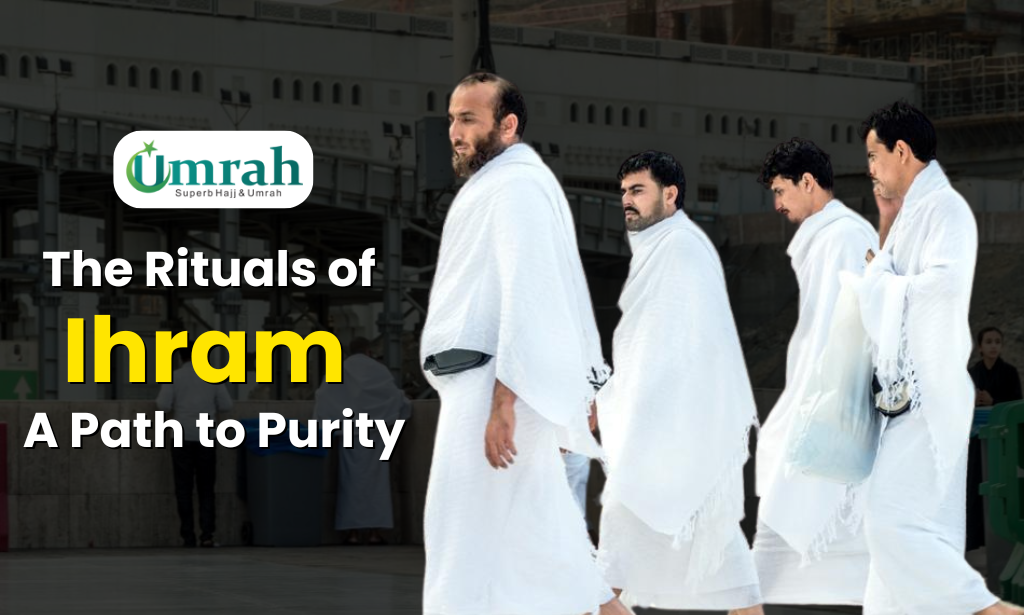
Millions of pilgrims head to Saudi Arabia to perform the holy pilgrimages of Hajj and Umrah every year. These pilgrims have to adhere to various regulations and rituals associated with the pilgrimage. One such requirement is of “Ihram”.
It is an essential aspect of the holy pilgrimages of Hajj and Umrah, and anyone setting out to perform either of the two pilgrimages must know about Ihram.
There is a popular belief that Ihram is just a piece of clothing a pilgrim must wear during Hajj and Umrah. However, that is only partially accurate. Ihram is more than just clothing, it is a state of absolute purity of both mind and body.
In this blog, we will dive into the various aspects of Ihram such as the meaning, significance, history and more. We will also discuss when to enter the state of Ihram and how to put on the clothing in the correct manner.
What is Ihram in Islam?
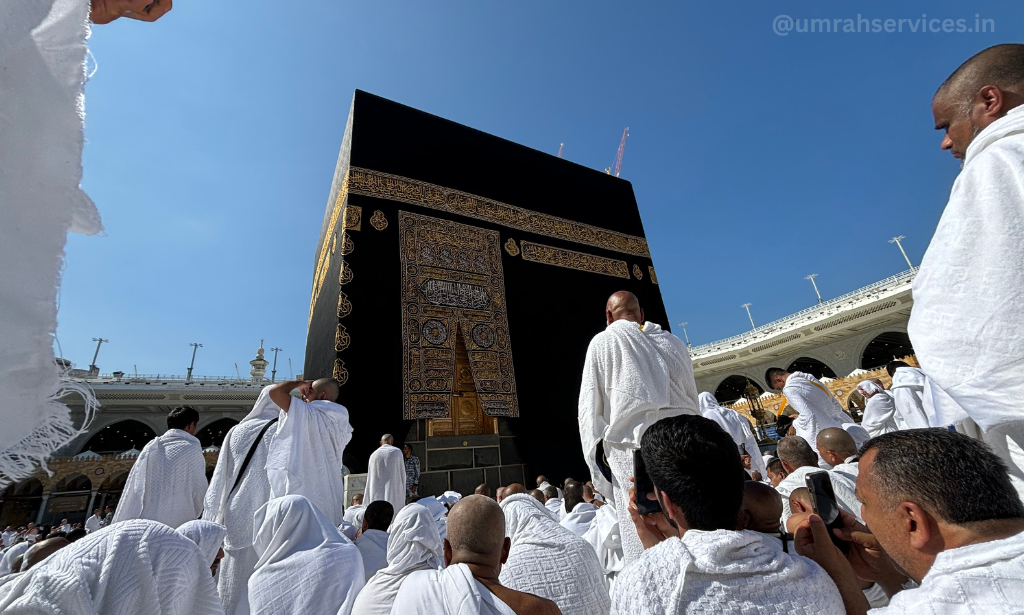
Ihram is more than a mere piece of clothing, it is considered to be one of the most important aspects in the rituals of Umrah and Hajj, the two sacred pilgrimages for the Muslim Ummah worldwide. It is immensely significant in the Islamic traditions. Ihram marks the beginning of a pilgrim’s journey.
The word “Ihram” is derived from the Arabic word “harama” meaning to forbid or to make sacred. Before crossing the sacred boundary of Mecca also known as Miqat, pilgrims are mandated to assume the state of Ihram. The pilgrim must enter this state after cleansing the body, wearing the prescribed attire, and making the intention before crossing the designated Miqat.
Significance of Ihram
Entering the state of Ihram has profound religious significance. It is a symbol of peace, harmony and unity where millions of Muslims from every walk of life shed their differences and appear as one in front of the almighty Allah. The Ihram brings a sense of unity to the pilgrims where all the believers have gathered together to worship Allah.
The two white garments that come together to form the Ihram are a symbolic representation reminding pilgrims about the death, resurrection and equality of all Muslims before the Almighty Allah.
The white sheet worn by the pilgrims during the pilgrimage is similar to the shroud used to wrap the dead bodies before they are buried. This serves as a reminder that death comes to all without discrimination so staying humble and following the path of Islam should be of prime importance.
This stark reminder inspires believers to stay away from the sins and evils of life and work to improve themselves as better Muslims.
Ultimately, Ihram expresses submission to the will of Allah, aligning the hearts and actions of the pilgrims according to the traditions of Islam. An Ihram is a reminder to all that the ultimate journey in life is toward Allah and the hereafter.
Understanding the Ihram Clothing

Ihram is a spiritual state as well as a physical state involving many rules and regulations, and one such rule is regarding the clothing that should be worn during the sacred pilgrimage.
Also Read:- A Guide to Ziyarat in Mecca & Medina
When you fly out to Mecca to perform either Umrah or Hajj, you have to be in the state of Ihram before crossing the point of Miqat depending on which direction you are coming from towards Saudi Arabia.
The spiritual significance of the Ihram is the same for both men and women, however, there are stark differences in how the state of the Ihram is observed by them, especially when it comes to clothing.
Ihram for Men
For men, Ihram consists of two white seamless articles of clothing. One wraps around the waist while the other is draped over the shoulder and covers the torso.
- Rida (The Upper Garment) – It is the covering that is to be worn over the shoulder, covering the torso, and leaving the right shoulder exposed, especially for certain rituals like Tawaf, which means circumambulation around the Kaaba.
- Izar (The Lower Garment) – The lower garment, covering the body from the navel to the ankles is known as Izar. It is securely wrapped around the waist.
These are simple, unstitched pieces of cloth, which remind one of the equality in rank of all believers, as no differentiation based on wealth or status may be displayed.
Men are not allowed to wear any sewn apparel, including underwear, socks, or shoes that cover either the ankle or toe.
Also Read:- Facts about Riazul Jannah
Ihram for Women
Women’s Ihram differs in that they do not have specific garments that they must wear. Instead, they are required to dress modestly in their everyday attire, which must meet the general requirements of the Islamic dress code. This includes covering the entire body, except for the face and hands.
Women are prohibited from covering their faces during Ihram, though they may wear loose-fitting and comfortable clothing that is typically white or light in colour. Unlike men, women are allowed to wear stitched clothing and can wear sandals or shoes that cover their feet. The emphasis for women’s Ihram is on modesty, simplicity, and cleanliness.
Rules for Ihram Clothing
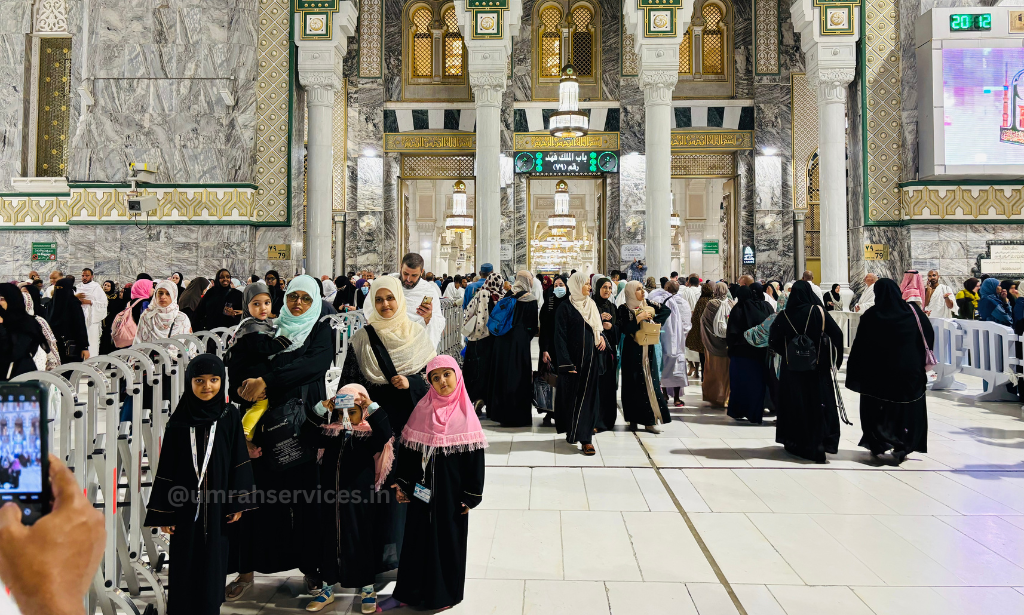
The moment you enter the state of Ihram, certain acts become prohibited for you to maintain this spiritual state. Some of the actions to be avoided are mentioned below:
- Wearing stitched clothes by men – White, unstitched cloth is to be worn by men at all times during the rituals of Umrah pilgrimage.
- Covering of head or face – A man must not cover his head and a woman is not to cover her face with a niqab nor wear gloves on her hands.
- Clipping nails or hair – It is forbidden to cut one’s hair or nails or to have someone else do so once you have entered the state of Ihram.
- Shoes/sandals covering ankles – The wearing of shoes or sandals that cover the ankle is not permitted.
- Wearing perfumes – Applying perfumes to the body or clothes is strictly prohibited.
- Cosmetics – The use of cosmetic products is prohibited and so is the use of perfumed soaps. One can take a bath, but this has to be done with unperfumed soaps.
- Killing Animals – It is not allowed to kill an animal or help do so.
- Sexual Activities – Any kind of sexual relation is not permitted.
All these prohibitions apply to the one performing Hajj and also to one who performs Umrah. For each of these violated rules, the penalty involves sacrificing a goat or sheep, known as Damm in Arabic.
The penalty may be heavier, depending on whether it was committed accidentally or out of negligence. So as not to commit any of these mistakes, it is useful to consult various recognised Islamic scholars and refer to trusted resources before embarking on Hajj or Umrah.
Also Read:- Nabeez Drink Health Benefits
When to Enter Ihram
Pilgrims setting out on either Hajj or Umrah are obliged to enter the state of Ihram before passing designated boundaries called Miqat. There are five Miqat points around Makkah, and they are set in such a way that every pilgrim coming from different directions has to pass through them.
The Miqat for the pilgrims differs according to where they are coming from:
- Dhul Hulayfah – Also known as Abyar Ali, this Miqat point is for those pilgrims arriving from the direction of Madinah.
- Al-Juhfah – It falls on the way for whoever approaches from the direction of Syria.
- Qarn al-Manazil (al-Sayl) – This Miqat point is for whosoever comes from Najd’s direction.
- Yalamlam – It is for whoever comes from Yemen’s direction.
- Dhat Irq – Suitable for whoever comes from Iraq.
When a pilgrim crosses the Miqat, they should already attain the state of Ihram; if somebody fails to enter Ihram before reaching the Miqat, he should return and re-enter it, or offer a sacrifice (damm) as an atonement.
How to Wear Ihram for Umrah
Wearing Ihram properly is the only way one can enter into the sacred state with which Umrah or Hajj is performed. It requires one’s getting ready both in body and spirit.
Herein is a detailed step-by-step guide on how to wear Ihram for both men and women, together with key considerations.
Also Read:- Five Pillars of Islam
Step-by-Step Guide for Men
Wearing Ihram for men consists of two plain, white clothes that are simple and unstitched: Izar (lower garment) and Rida (upper garment). This is a simple process but must be done with modesty and comfort in mind.
- Cleanse Yourself – Get yourself ready to wear these Ihram garments by cleansing your body:
- Ghusl (ritual bath) – Take Ghusl as a means of purifying your body. You can replace it with Wudu (ablution) if Ghusl is not possible.
- Shaving and Trimming – You can trim your nails, shave the armpits, and clean any unwanted body hair before entering Ihram as these activities will not be allowed after entering the state of Ihram.
- Do not use perfumed products – Do not apply any perfumes or scented lotions or soaps after your bath. You may use unscented soap.
Wearing the Izar (Lower Garment)
- Wrap the Izar – The Izar is that part of the Ihram which begins from the navel and extends right up to the ankles. Take one of the white clothes and start wrapping it around your waist like a towel.
- Preserve modesty – Tie the Izar in such a way that does not fall and keeps you decent. Let it cover you completely and come right up to the ankles. You can tie your waist either with a belt (avoid wearing leather belts) or an Ihram belt to keep your Izar intact.
Wearing of Rida (Upper Garment)
- Drape the Rida – It is the second white garment that is used to cover the upper part of the body. Throw it over your shoulder in a way that it should cover the torso. The drape should be kept in such a way that it must have enough room for air to pass but at the same time not to slip away.
- Expose the right shoulder while in Tawaf – In Tawaf, expose your right shoulder by taking the Rida under your right arm and then over your left shoulder. This is called Iztiba and should only be done in Tawaf.
Wearing appropriate shoes or slippers
Men must wear sandals or slippers in which the ankle and the top of the feet should not be covered. Wearing shoes that cover these areas is not allowed.
How to Wear Ihram for Women
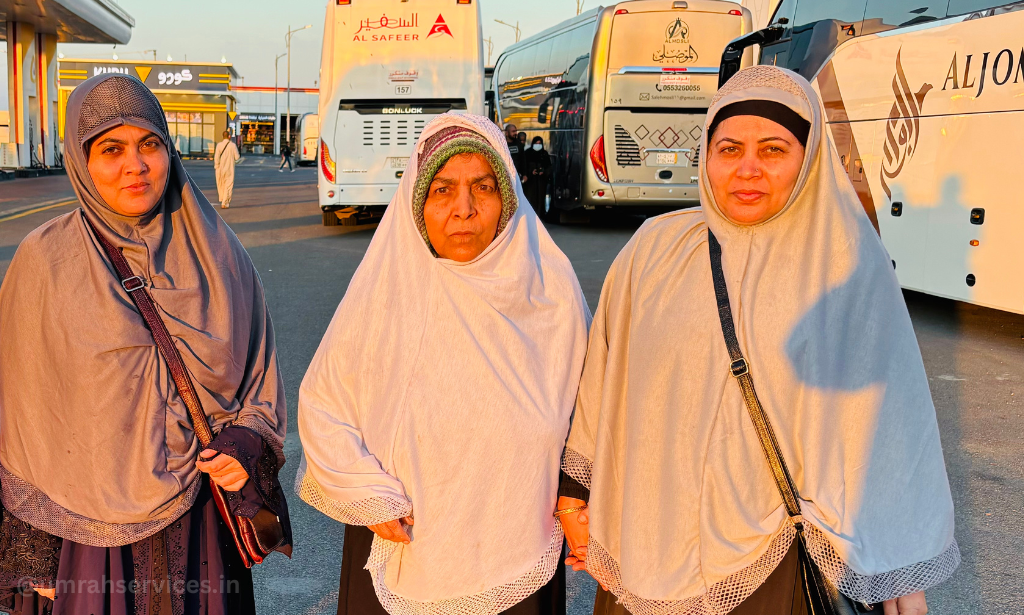
Wearing Ihram for women is an easier process as it does not involve any special garments. Women can wear their usual clothes provided they are modest. However, there are a few important things to note when trying to wear Ihram correctly.
Also Read:- Book Umrah Package from Delhi
Purify Yourself
Like men, women need to take Ghusl or Wudu to get ready for Ihram. This is advisable for purification. If Ghusl is not possible, then doing Wudu will suffice.
Dress Up Modestly and Simple
- The women do not have special garments for this purpose like men, but they must be properly attired according to the Islamic code of dressing. Women usually wear long gowns that are simple and plain, covering them except the face and hands. Any colour can be used on the dress although white is preferred since it signifies purity.
- Women should cover their heads with a hijab in such a way that no hair should be visible. The hijab is to be soft, not uncomfortable, or too tight.
- Women are not allowed to wear any makeup, perfumes, or other beauty products. All scented items are forbidden in Ihram.
Do Not Cover the Face
According to Islamic rules, women cannot cover their faces after assuming Ihram. However, if a woman feels threatened-for instance, if she finds herself in the middle of a mixed crowd-she may cover her face with a loose piece of cloth or even her hand provided it does not touch the face.
Conditions of Ihram
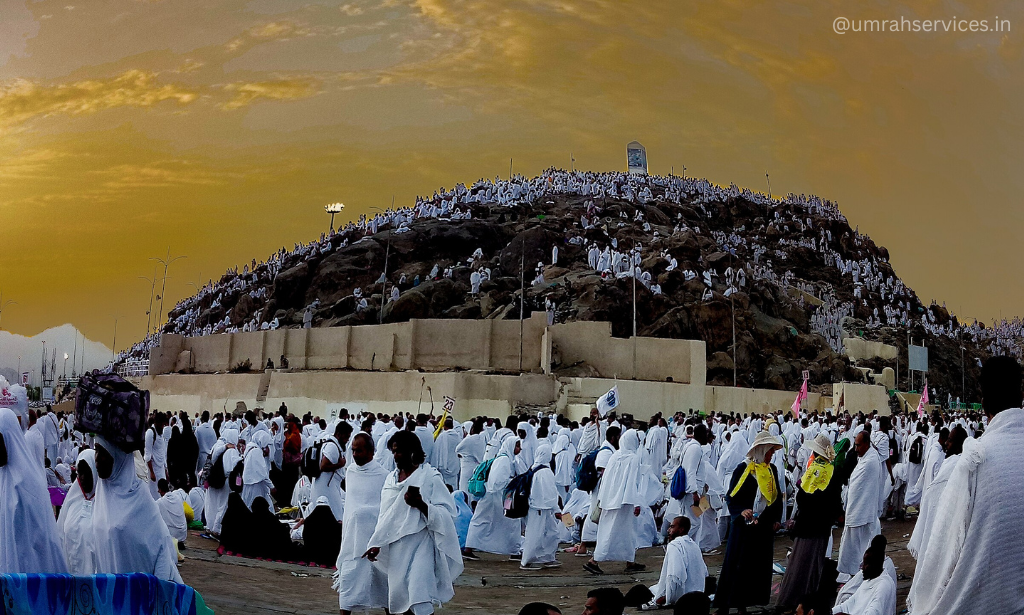
From the time a pilgrim enters Ihram or the state of purity, several conditions and restrictions are to be observed to maintain the sanctity of the pilgrimage. There are things a pilgrim in Ihram can do and cannot do.
Permissible Acts in Ihram
- One can bathe or wash oneself for cleanness, but refraining from scented soaps or lotions is imperative.
- Ihram garments can be changed if needed, but in such cases, one must remain in the state of Ihram.
- One can use unscented toothpaste or lotion since the prohibition is against perfume.
- The pilgrims can take medicine in Ihram as long as the medicines do not include forbidden items. Even injections and vaccinations are permissible.
- Killing potentially harmful animals/insects such as snakes, scorpions, flies and cockroaches.
Prohibited Acts
Once in the state of Ohram, pilgrims have to take precautions and avoid a lot of prohibited activities such as;
- Grooming: Hair or nails are not allowed to be cut during the state of Ihram.
- Perfume: Pilgrims are not allowed to wear perfume or any type of fragrant stuff on their bodies and clothes.
- Killing animals: Pilgrims must not kill animals, including insects under Ihram.
- Marital relations: All types of relations with the wife are prohibited, including any talking or gesturing that may lead to intimacy.
- Controversies and quarrels: Ihram prohibits the pilgrim from any type of controversy or quarrel, even in a defensive manner.
- Stitched clothing: It is strictly prohibited, even shoes covering the ankle, are not permitted to be worn by males.
- Covering of the face for women: Facing the obligation for women not to cover their faces, while it is allowed to just cover their heads with a scarf, called hijab.
Any of these prohibitions violated will invalidate the state of Ihram, and require the pilgrim to offer a sacrifice as an atonement (dam).
Amendments for Breaking Ihram Rules
Once the pilgrim attains the state of Ihram for Hajj or Umrah, there are certain prohibitions and restrictions which have to be kept.
In case any one of these prohibitions is violated the pilgrims have to pay certain penalties or compensations commonly known as Fidyah (atonement). The nature of the offence committed would determine the penalty imposed.
Also Read:- How to do Umrah Preparation
Here are some of the common compensations in case the state of Ihram is violated:
- Dam (Sacrifice) – It involves the slaughter of an animal, usually a sheep, goat, or a share in an animal of a larger size, like a camel. This is the most widespread penalty and becomes necessary on the commission of heinous violations of Ihram.
- Sadaqah – This involves giving away food or money as alms to needy people. Sadaqah is less penalty than Dam. It is usually imposed concerning minor or accidental offences.
- Fasting – If he cannot afford to sacrifice or give in charity, he has then to fast. The days depend upon the grievousness of the offense and vary between one to ten days.
Conclusion
As pilgrims assume this sacred state, detachment from worldly distractions happens, and they become wholly dedicated to worship.
Ihram is more than a physical state; it’s a spiritual journey towards self-discipline, humility, and closeness to Allah. The white clothes that men wear and women’s modest dress mirror the equality of all Muslims by reminding them that worldly distinctions do not bear any weight in the eyes of Allah.
By keeping the conditions of the Ihram and focusing on spiritual purification, the pilgrims hope to please the Almighty Allah and attain his forgiveness so that at the end of this pilgrimage their hearts will be filled with faith and devotion.
Frequently Asked Questions
Q. Can I wear a belt with Ihram?
A. Yes, men are permitted wear a belt with their lower garment (Izar). Although, it is advised to avoid wearing a leather belt.
Q. What is Miqat in Umrah?
A. It is the sacred point (boundary) at which the pilgrims intending to perform Umrah and Hajj must enter into the state of Ihram. There are five designated Miqat points for pilgrims coming from all directions.
Q. Do Men and Women’s Ihram Differ?
A. Yes, in terms of clothing the men and women have a clear difference in Ihram. Men wear two pieces of white unstitched clothing namely Rida and Izar weheras women do not have any specific requirements. They can wear their regular clothing according to Islamic traditions provided they are modest.
Q. How to wear Ihram?
A. Ihram is worn by wrapping two white pieces of unstitched clothing. One, called Izar, is wrapped around the waist covering the body from the navel to the ankles, and the other, called Rida, is thrown over the shoulder covering the upper portion of the body.
Q. Can Ihram clothing be changed?
A. Yes, it permissible to change Ihram clothing as many times as may be required.
